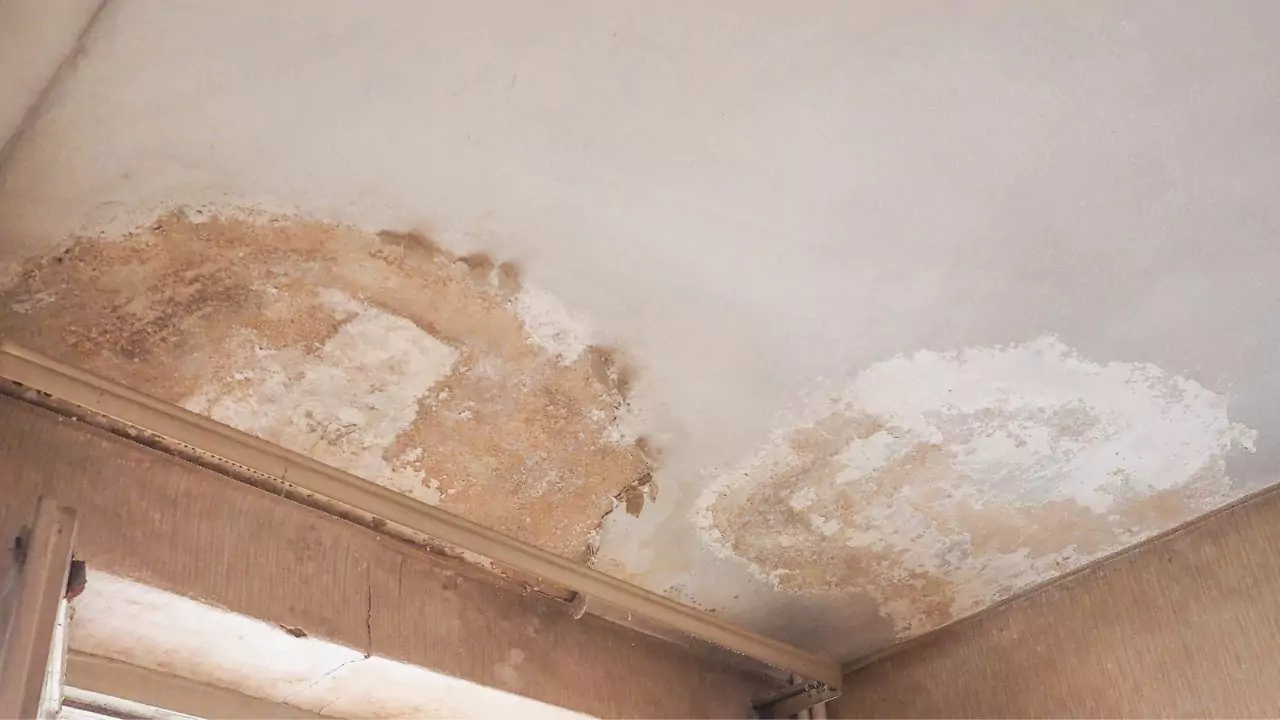Most Home Insurance policies don’t cover damp issues. This is because damp problems are considered maintenance problems and gradual deterioration. However, some insurance providers may offer separate coverage for growing damp.
Understanding Damp
What is Damp?
Damp is the presence of excess moisture in a building, either on the surface or within the walls, floors, or ceilings. Damp can be caused by various factors, such as leaking pipes, faulty roofs, poor ventilation, or rising groundwater. Damp can lead to various problems, such as mold growth, rotting wood, peeling wallpaper, stained plaster, or musty smells.
Types of Damp
Three main types of dampness can affect a house: rising dampness, penetrating dampness, and condensation.
- Rising dampness occurs when moisture from the ground rises through the walls or floors of a building. This can happen if the damp-proof course (a barrier that prevents moisture from rising) is damaged, missing, or bridged by external factors, such as soil, debris, or plants. Rising dampness can cause salt deposits, tide marks, or damp patches on the walls or floors, as well as damage to the plaster, paint, or wallpaper.
- Penetrating dampness occurs when water from outside seeps through the walls, roofs, or windows of a building. This can happen if there are cracks, holes, or defects in the external structure of the property, or if the drainage system is blocked or faulty. Penetrating dampness can cause wet spots, mold, or rot on the walls, ceilings, or floors, as well as damage to the insulation, wiring, or fittings.
- Condensation occurs when warm, moist air meets a cold surface and turns into water droplets. This can happen if there is inadequate ventilation, heating, or insulation in the property, or if there are sources of moisture, such as cooking, showering, or drying clothes. Condensation can cause mold, mildew, or damp patches on the walls, ceilings, or windows, as well as damage to the furniture, fabrics, or carpets.
Causes and Signs of Damp
Causes of Damp
The causes of dampness can vary depending on the type and location of dampness, as well as the age and condition of the property. Some of the common causes of dampness are:
- Leaking pipes, taps, or appliances
- Faulty roofs, gutters, or flashings
- Cracked or damaged walls, bricks, or mortar
- Poorly fitted or sealed windows or doors
- Blocked or overflowing drains or pipes
- High water table or flooding
- Lack of ventilation, heating, or insulation
- Excessive moisture production from cooking, showering, or drying clothes
Signs of Dampness in a House
The signs of dampness in a house can vary depending on the type and severity of dampness, as well as the location and material of the affected area. Some of the common signs of dampness are:
- Mold or mildew growth on the walls, ceilings, or windows
- Damp or musty smell in the rooms or cupboards
- Peeling or bubbling paint, wallpaper, or plaster
- Stained or discolored walls, ceilings, or floors
- Rotting or warped wood, skirting boards, or floorboards
- Salt deposits, tide marks, or damp patches on the walls or floors
- Wet or cold spots on the walls, ceilings, or floors
- Condensation or water droplets on the windows or walls
Treatment and Prevention of Damp
How to treat rising dampness?
The treatment of rising dampness depends on the extent and cause of the problem, as well as the type and condition of the property. Some of the possible treatments are:
- Repairing or replacing the damp-proof course
- Injecting a chemical damp-proof course into the walls
- Installing a physical damp-proof membrane under the floors
- Applying a waterproof coating or plaster to the walls
- Removing or lowering any external factors that bridge the damp-proof course
- Improving the drainage and ventilation around the property
How to treat penetrating dampness?
The treatment of penetrating damp depends on the source and location of the water ingress, as well as the type and condition of the property. Some of the possible treatments are:
- Fixing or replacing the leaking pipes, taps, or appliances
- Repairing or replacing the faulty roofs, gutters, or flashings
- Filling or sealing the cracks, holes, or defects in the walls, bricks, or mortar
- Replacing or fitting the windows or doors properly
- Clearing or repairing blocked or overflowing drains or pipes
- Applying a water-repellent coating or paint to the external walls
How to Prevent Damp?
The prevention of dampness depends on the type and cause of dampness, as well as the type and condition of the property. Some of the possible prevention measures are:
- Regularly checking and maintaining the plumbing, roofing, and drainage systems
- Ensuring adequate ventilation, heating, and insulation in the property
- Using extractor fans, dehumidifiers, or air conditioners to reduce moisture levels
- Opening windows or doors to allow air circulation
- Avoiding drying clothes indoors or using a tumble dryer with a vent
- Cleaning and removing any mold or mildew growth as soon as possible
Insurance Considerations
Is rising dampness covered by house insurance?
Rising dampness is usually not covered by house insurance, as it is considered a maintenance issue rather than an accidental or sudden event. Most insurance policies exclude damage caused by wear and tear, gradual deterioration, or lack of maintenance. Therefore, it is the responsibility of the homeowner or landlord to prevent and treat rising dampness, as well as to bear the costs of any repairs or renovations.
Can you claim for damp on your insurance policy?
You can claim dampness on your insurance policy only if it is caused by an insured event, such as a storm, flood, fire, or burst pipe. In that case, you need to prove that the dampness was a direct result of the event and that you took reasonable steps to prevent or minimize the damage. You also need to report the claim as soon as possible and follow the instructions of your insurer. However, you cannot claim for dampness if it is caused by poor maintenance, faulty construction, or negligence.
Is it possible to sell a house with dampness?
It is possible to sell a house with dampness, but it may affect the value, attractiveness, and legality of the sale. If you are selling a house with damp, you need to:
- Disclose the damp problem to the potential buyers, as well as any treatments or repairs that you have done or plan to do.
- Provide a damp survey or report from a qualified professional, as well as any guarantees or warranties for the work done.
- Negotiate the price and terms of the sale with the buyers, taking into account the cost and inconvenience of dealing with the damp.
- Comply with the legal requirements and regulations for selling a property, such as obtaining a home report, energy performance certificate, or building warrant.





